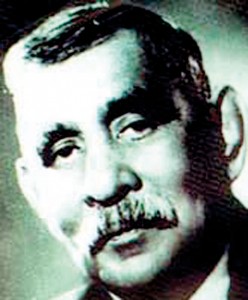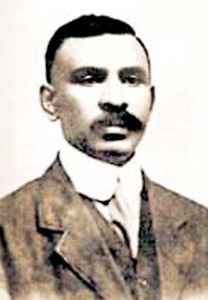Sunday Times 2
From 1915 to Independence
The year 1915 changed the political history of this island. The unjust harassment of a group of prominent young men by the British authorities created a feeling of anxiety among the people including those who had never entertained political ambitions.
The Temperance Movement had been sparked off by legislation directed at raising government revenue by opening new arrack and toddy taverns in all parts of the country.
When communal disturbances erupted, the colonial government imposed martial law under the pretext of quelling the riots but committed several atrocities against the freedom fighters of the anti-liquor movement with a view to suppressing the emergence of a national movement.

Unfairly arrested and tormented: Sri Lanka’s first Prime Minister D. S. Senanayake
Governor Sir Robert Chalmers’ authoritarian action led to the birth of a national freedom movement. The three Senanayake brothers of Bothale — FR, DC and DS (later first Prime Minister) — were in the forefront of nurturing and fertilising the plant until it bore fruit 33 years later.
It all began on May 28, 1915, (Vesak Poya Day) when the organisers of a Buddhist procession defied orders to stop drum beating while passing a mosque in Gampola town. A. Ratnayake, a Minister and former Chairman of the Senate recalled an eyewitness account: “I was a 14-year-old school going child. I can remember, as I was standing beside the carol cart, someone threw a bottle; the people from the mosque started hooting and hitting us with stones, clubs and whatever they picked up. Our people entered the Mosque and destroyed it. Muslim boutiques were attacked too, and set fire to houses…” Clashes that erupted island-wide accounted for 63 lives.
Governor Sir Robert Chalmers declared martial law empowering the military to shoot at sight. D.S. Senanayake, his two brothers, FR and DC, and many national leaders working on Temperance Movement were unfairly arrested and tormented.
In May 1915…in his statement to the authorities after his arrest, the 30- year-old D.S. Senanayake said,
“…. A town guard came to my residence around 5.30 a.m. along with two armed Punjabi soldiers, woke me up and without allowing me to go to the toilet…, took me to Welikade prison and put me in a convict’s cell where I had no place to sit. There were quite a number of prominent gentlemen locked up in solitary confinement. We were imprisoned with no one to talk to, a servant pushed some dirty food in an unclean tin plate which disgusted me, and naturally I was unable to take it. I stayed hungry for two days…., I was charged for instigating riots, and there was no evidence to prove the charge…”
On June 8, the Town Guard Punjabi soldiers came to FR’s house searched it before taking him into custody without giving any reason. They simultaneously raided DC’s house and took him to Welikade prison.
A letter dated June 14, 1915, written by F.R. Senanayake to Sir P. Ramanathan, the member representing the Educated Ceylonese in the Legislative Council, said ” … at about 8.00 p.m. on the 1st June, a Muslim man living near my brother’s [DS] house, came running to us terrified, and appealed to us to protect him from thugs…I and my brother went there and chased away the crowd, and my brother brought the Muslim family

F. R. Senanayake
to his house…” – Deshamanya F R Senanayake; Dahanayake- pp.68
In a strange turn of events all three Senanayake brothers played an active role in the Temperance Movement in spite of the fact that their father, Don Spater Senanayake, built his empire re-investing profits earned from graphite mining and the arrack and toll renting trade.
The Senanayakes were detained along with D.B. Jayatillake, H. Amarasuriya, A. E. Gunasinhe, John de Silva, F.R. Dias Bandaranaike and Edwin Wijeratne, the other national leaders. The brother of Anagarika Dharmapala, Edmund Hewawitarne died in a Jaffna prison. The Colonial Government feared the birth of a freedom movement under the guise of the ‘Temperance Movement’, where the young Senanayakes played a prominent role. Several national leaders were court martialled and executed by firing squad under Martial Law.-’100 Days in Ceylon under Martial Law’: Armand de Souza-1916
R.A. Mirando, President of the Buddhist Theosophical Society, [BTS] was another victim; the Colonial Secretary explaining said ‘…he was shot by accident’. The others who were imprisoned in penal cells without trial were W.A. de Silva, Arthur V. Dias and a host of active members of the Buddhist cause. Young DS’s involvement in the anti-arrack campaign with his brothers was closely monitored by the British and they were determined to suppress the campaign as they were suspicious of the young radical movement transforming into a national freedom movement. They also had concerns about declining Arrack rental income.
When the Legislative Council met for the first time after the riots on August 6, 1915, under the chairmanship of Governor Chalmers, he addressing the assembly stated,
” …Ceylon has suffered a great calamity…one section of His Majesty’s subjects has attacked another section. The assailants were Buddhists Sinhalese; the victims were peaceable Muslims… the attack began at Kandy on the night of 28th May, the nativity of Gautama the Buddha; like wildfire it spread …to Rambukkana, and thence through Colombo down the coast to Matara …what has be fallen the Muslims at Sinhalese hands in the five provinces is that their property has been looted , their houses and shops have been wrecked, their Mosques have been desecrated and destroyed , and they have themselves been wounded, outraged and murdered …” – -Hansard: 6/8/1915: fol. 330
“…They were jailed for 46 days…for allegedly organizing anti-Muslim rioting in 1915. This propelled them into national prominence, leading S.C. Obeysekere, to denounce them as ‘Nobodies’ trying to be ‘Somebodies’ but nobodies were soon on their way to the top of the political ladder.” -Nobodies to Somebodies-2007: Kumari Jayawardene
The British Governor and Edward Stubbs, Colonial Secretary, advised by British officials, surmised the unrest, rioting and the Temperance Movement to be a revolt against the King – which compelled them to enforce martial law. The execution of Henry Pedris, a young Army officer, on trumped up charges and exploiting the situation to ‘teach a lesson’ to other Nationalist leaders of the time was the strategy adopted by the British for the fear of birth of a freedom movement. Pedris’ skill as a marksman made the Colonial military resentful of him. In 1915, a high ranking British official created a scene inside a City’s Cinema hall by deliberately demanding the seat from Henry Pedris, which he bluntly refused. With riots breaking out an opportunity arose; charges were framed on a fictitious story created by the British officials and their local henchmen that Pedris opened fire at a group of Moors and instigated the Sinhalese to march towards the city from Peliyagoda.
Colonel Henry Pedris, 27, was charged with incitement of communal violence. However, the charges against Pedris were subsequently proved false. The colonial authorities did not stop at that: the blood splattered chair used in the execution was taken to the prisons as an ‘exhibit’ where the Temperance Movement leaders were detained; the motive was to ‘teach a lesson’.
C.P. Dias, a senior member of the Colombo Municipality and Principal of Wesley College, Colombo prepared a report on the riots at the request of Sir Ponnambalam Ramanathan. The village population in Ceylon in 1915, constituted 85 per cent of illiterate lower classes of the Sinhala and Muslim community compared to today’s high literacy rate and social standards. He wrote: “…the disturbances appear to have been a sudden outburst of feelings of resentment on the part of lower classes of Sinhalese, the Artisans and the unemployed against the Moslems…” – C.P. Dias
Sir Ponnambalam Ramanathan, a respected national leader, and E.W. Perera, a lawyer from Kotte, visited the Sinhalese leaders in prison and obtained affidavits from them for submission in England accusing the government officials. E. W. Perera carried a secret document addressed to the Secretary of State for Colonies. It was hidden in the sole of his shoe. Martial law was repealed, the charges were probed, Governor Chalmers lost his job and was summoned back home to be replaced by Sir John Anderson.
The riots were just a religious brawl of a type that was common in the region. The authorities panicked and over-reacted because of the war in Europe where Britain and Germany were involved. A well-organised campaign asking for a commission to investigate atrocities by British rulers compelled them to oblige; but the final report stated,
“…ten of the executions were illegal, but that they were carried out in good faith”
In his autobiography, Nelson Mandela says, “For to be free is not merely to cast off one’s chains, but to live in a way that respects and enhances the freedom of others.”

